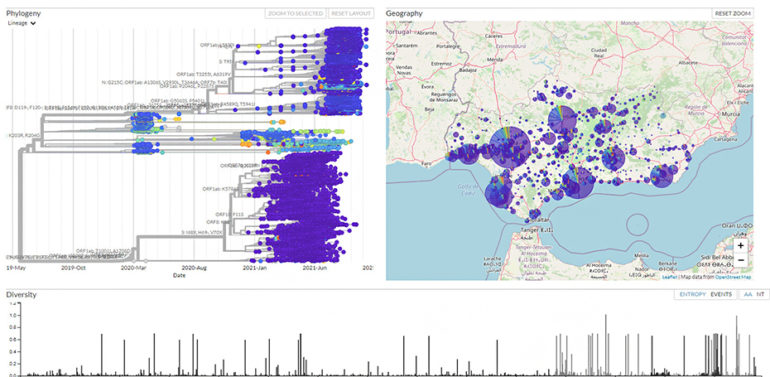
The work of the Andalusian public health system has positioned the autonomous community at the forefront of genomic sequencing of coronavirus at the national level. Currently, 13,880 coronavirus samples have been sequenced, which represents 59.3% of what has been sequenced in the whole country, according to data from the SeqCovid project.
The genomic analysis of samples from patients who have suffered from Covid-19 provides a better understanding of the disease and its behaviour to be able to offer effective therapeutic alternatives. In addition, thanks to genomic sequencing, a phylogenetic study of the virus can be carried out, showing the mutations it undergoes over time, its characteristics, and its possible relationships with variants from other countries or locations, which facilitates the detection of virus introductions and transmission chains. The results of the progression of this study are publicly available.
This work is possible thanks to a stable and well-structured circuit implemented by the Regional Ministry of Health and Families, through the General Directorate of Public Health and Pharmaceutical Organisation, with the support of the Andalusian Health Service, which allows the identification and analysis of patient samples. This circuit is part of the integration of the genomic sequencing of SARS CoV-2 in the surveillance tasks carried out by the Andalusian Epidemiological Surveillance System. This is a collaborative network for the epidemiological control of the pandemic that allows us to know how the coronavirus has been transmitted in Andalusia since the beginning, which areas have had the highest rate of infection, and also how the health measures that have been implemented have influenced it, among other aspects.
Thus, the genomes have been sequenced in the two reference hospitals designated for this purpose: the Virgen del Rocío Hospital in Seville, for samples from hospitals and primary care centres in the western part of Andalusia (the provinces of Cadiz, Cordoba, Huelva, and Seville); and the San Cecilio Hospital in Granada, for those from the eastern part (Almeria, Granada, Jaen, and Malaga). The information obtained has been analysed in the Clinical Bioinformatics Area of the Progreso y Salud Foundation, where an epidemiological map of the virus is interpreted and configured. This work has been promoted by the General Secretariat for R&D&I in Health.
Sequencing the genome of the virus “is like reading the instruction book to decipher how it works,” explains Joaquín Dopazo, director of the Clinical Bioinformatics Area. “This allows us to compare each instruction book and see similarities and differences between them that can be related to their greater or lesser transmissibility or even to different patient symptomatologies,” he says.
Professionals from the Clinical Bioinformatics Area of the Progreso y Salud Foundation have recently participated in the updating of the Covid-19 disease map, a project promoted by the Disease Maps community, an international network that brings together researchers from all over the world to define and create disease maps. Up to 162 experts from 25 countries have participated in the development of this map, which has just incorporated the latest developments and has been published in the journal Molecular Systems Biology, from the international publishing group EMBO.
The Andalusian researchers have made a significant contribution to this work by defining the mechanisms by which the hitherto known symptomatology is triggered, such as inflammation and exacerbated immune response, pulmonary blood pressure, haemoglobin degradation, etc. The COVID-19 map is a graphical and interactive representation of the molecular mechanisms relevant to the disease linking various sources of knowledge.


